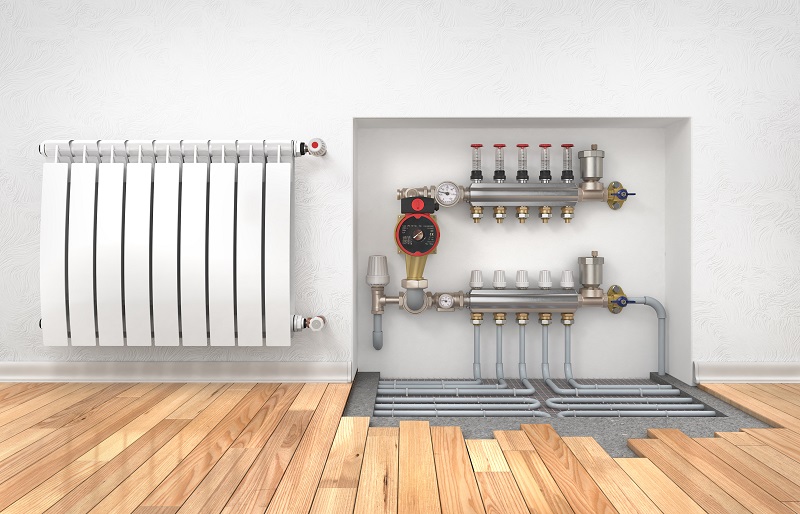
Are you tired of battling cold spots in your home during the winter months? Have you ever wondered if there’s a more consistent way to deliver warmth to your living spaces? Or perhaps you’ve heard about hydronic heating systems and are interested in learning more? Welcome to a comprehensive exploration into this renowned home improvement solution. This article will dig deep beneath the surface to dissect how hydronic heating systems operate, why they might be beneficial for your home, and debunk common myths surrounding this heating method.
Hydronic heating systems, often an unseen but integral part of many houses, are not as mystical as they might initially seem. These systems adeptly substitute forced-air heating methods, relying on water instead of air as the medium to carry warmth around your home. Join us as we walk through the fundamentals of hydronic heating, dispel common misconceptions, and illuminate the potential advantages of switching.
This article sets out to examine the complexity and charm of one of the most underestimated parts of the home – the heating system. We aim to provide a clear understanding of its complexity, its elegance, and above all, its admirable functionality. It’s time to turn up the heat and embark on a journey of understanding your home like never before.
What is Hydronic Heating?
In simple terms, hydronic heating is a method in which hot water or steam is used to heat your home – carried through a group of pipes snaking their way around your living spaces. These pipes, either hidden in the walls or laid under the floor, create a network of central heating, ensuring uniform warmth across the entire property.
In contrast to its air-blown counterparts, hydronic heating is praised for its silent, efficient, and allergen-free operation. It is something like an unsung hero, tirelessly working behind the scenes to create a warm and comfortable living environment.
Imagine a winter afternoon, where instead of the gusts of hot air causing sudden spikes in temperature, you experience a gentle, ambient warmth enveloping your home. Thereby creating a cozy atmosphere, perfect for nesting in with a good book or cherished company. That’s hydronic heating for you!
Why Opt for Hydronic Heating?
If you’re someone who values efficient, unobtrusive heating, hydronic heating just might be your answer. This heating system, on average, uses 20% less energy than a conventional forced-air system. This directly translates to lower energy bills and a reduced carbon footprint for you.
Hydronic heating is not only friendlier to your wallet and the environment, but it is also beneficial to your health. Unlike traditional heating, it doesn’t circulate allergens and dust around your home. It also avoids the air-drying effect associated with conventional heating methods, preserving a comfortable humidity level.
Moreover, hydronic heating systems are whisper-quiet. Say goodbye to disruptive, distracting noises often associated with air-based systems. Go ahead and enjoy that movie or have that important virtual meeting without background clatter.
The Science Behind Hydronic Heating
Understanding the basics of hydronic heating is a rewarding journey into the intricacies of fluid dynamics and thermodynamics. At the heart of the system is the boiler, heating water to the desired temperature. This water is then pumped into the system of pipes, radiating out heat as it circulates.
The fact that water has a higher heat capacity than air is central to the efficiency of hydronic heating. In essence, a small quantity of heated water can carry more heat energy compared to a similar volume of heated air.
Furthermore, hydronic systems capitalize on the natural tendency of hot substances to rise while cold substances sink. As the radiator emits warmth, cool air is drawn into the bottom, heated, and then dispersed upward to circulate and heat the room uniformly.
Pros and Cons of Installing a Hydronic Heating System
Like any major home improvement initiative, hydronic heating also has its strengths and weaknesses. While the upfront cost may be higher than traditional heating methods, it offsets this through lower energy bills over time.
As for the aesthetics, modern hydronic systems are designed to be compact and discrete. However, this may require substantial structural modifications in some homes, leading to increased installation complexity and cost.
Adding Value to Your Home with Hydronic Heating
Investing in hydronic heating not only ensures overall warmth but also significantly enhances the value of your home. Potential buyers are increasingly recognizing the efficiencies, health benefits, and increased comfort of hydronic systems, positioning your property as a premium offering in the market.
Conclusion
There’s no understating the importance of a reliable, efficient and health-conscious heating system for your home. Hydronic systems hit that trifecta, paving the way for a wave of transformative benefits. If you’re open to an initial investment and minor structural modifications, a hydronic heating system could be your key to a healthier, more comfortable, and energy-efficient living. In short, it’s more than a heating system; it’s a lifestyle upgrade. Embrace hydronics, embrace warmth!